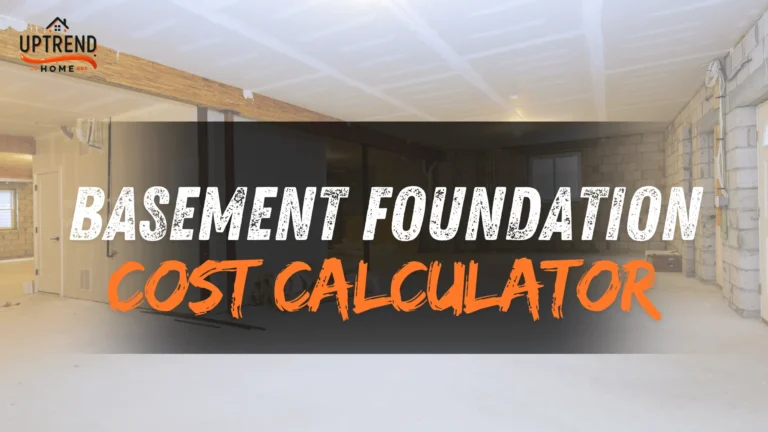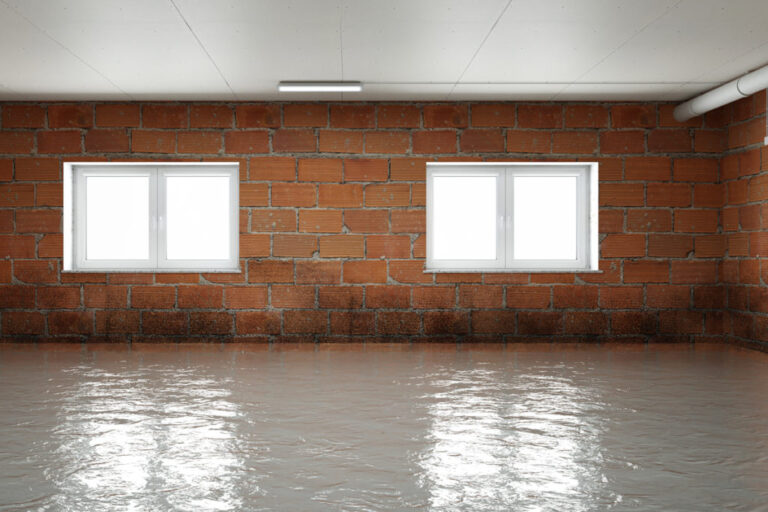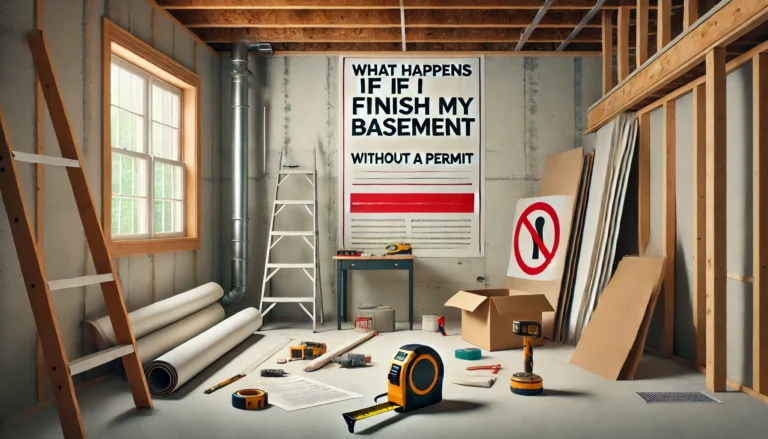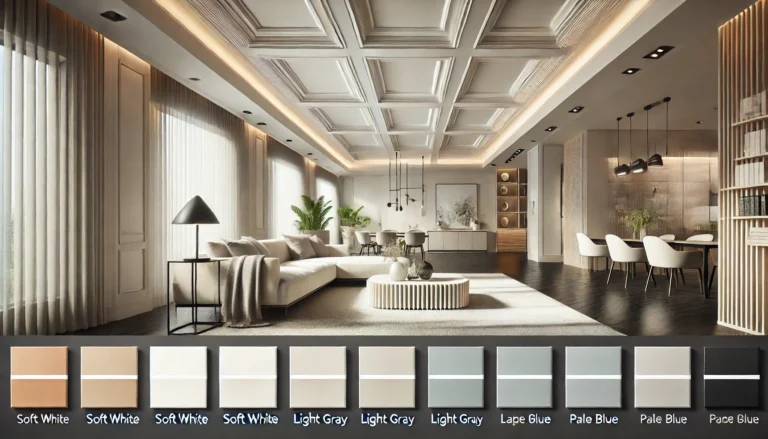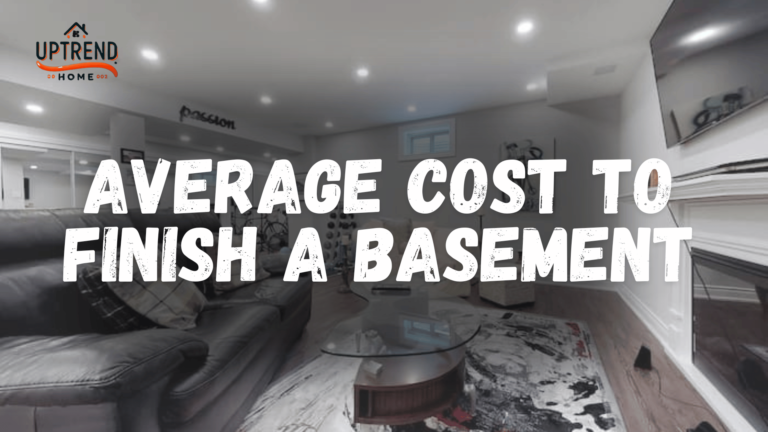Creative and Functional Basement Playroom Ideas for Kids
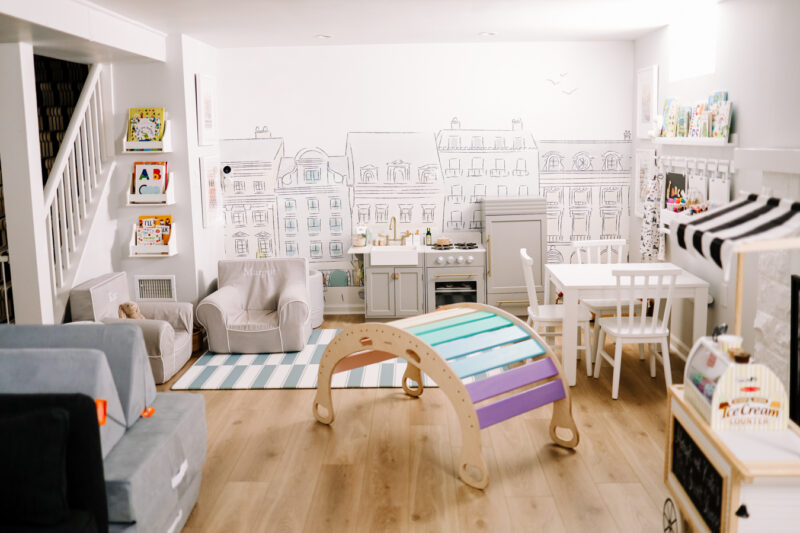
Why Create a Basement Playroom?
Turning your basement into a playroom isn’t just a fun idea—it’s a smart one! A dedicated basement playroom can transform how your kids learn, play, and interact with their surroundings, offering a customized, safe, and fun space for them to enjoy.
Benefits of a Dedicated Playroom Space
- Organized Living Areas:
Say goodbye to toys scattered all over the house! A basement playroom keeps your main living spaces clutter-free, giving your home a more organized feel. With playroom storage solutions such as shelves and bins, everything has its place, and your family can enjoy a tidier home environment.
- Safe and Contained Fun:
With a basement playroom, you can create a controlled and safe environment for kids to play, ensuring their safety while they explore and have fun. The childproofing of the space ensures peace of mind for parents.
- Encourages Independent Play:
Kids are more likely to engage in independent play when they have a space designed just for them. A playroom design that includes imaginative play areas helps develop their creativity, problem-solving skills, and independence.
- Tailored to Your Family’s Needs:
A basement playroom can be customized with toys, furniture, and decor that match your child’s age and interests. From a reading nook to an arts and crafts corner, the possibilities are endless. Tailoring the playroom furniture to your child’s preferences creates a unique space that sparks creativity.
How a Playroom Helps Kids Learn and Play
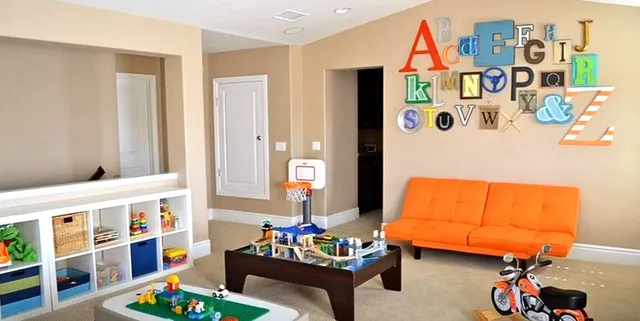
- Promotes Cognitive Development:
Basement playroom ideas like puzzles and games challenge your child’s thinking and problem-solving abilities, promoting cognitive development in a fun way. - Encourages Physical Activity:
Adding features like play mats, small slides, or even a climbing wall encourages physical activity and motor skill development. - Boosts Social Skills:
Hosting playdates in a designated playroom encourages kids to share, collaborate, and build friendships in a safe, fun environment. - Supports Emotional Growth:
Having a space to play freely allows kids to express their emotions, reduce stress, and build confidence in their abilities. - A Creative Outlet:
A playroom can include areas for art, music, and role-playing, giving kids the tools they need to explore their creativity and talents.
12 Amazing Ideas for a Basement Playroom
Transform your basement into the ultimate play zone with these exciting and practical basement playroom ideas!
1. Add a Mini Indoor Playground
Turn your basement into an adventure haven with a mini indoor playground! Include features like a climbing wall, monkey bars, or even a small slide to keep kids active and entertained. You can customize the setup with soft padding and safety features, ensuring a secure environment for endless fun. This setup promotes physical activity and helps burn off energy on rainy days.
2. Use Clever Storage Solutions
Organize toys and supplies with shelves, bins, and baskets. Opt for labeled storage or furniture with hidden compartments to maximize space while keeping everything tidy. Use wall-mounted organizers and stackable storage to make the most of vertical space. This keeps the playroom clutter-free and helps kids develop good organization habits.
3. Choose Colorful Walls and Decor
Brighten the room with playful colors, murals, or wallpaper featuring your child’s favorite themes. Vibrant decor creates a cheerful and stimulating environment. Consider using peel-and-stick wallpaper or decals for easy updates as your child’s interests evolve. Complement the walls with matching rugs, cushions, and curtains to create a cohesive and lively atmosphere.
4. Create a Quiet Reading Nook
Set up a cozy corner with bean bags, cushions, or a small tent for quiet time. Add a bookshelf stocked with their favorite books to inspire a love of reading. A well-lit reading lamp and soft textures make the space inviting and relaxing. This dedicated nook encourages literacy and provides a peaceful retreat from active play.
5. Pick Kid-Friendly Flooring Options
Choose soft, durable flooring like foam mats, carpets, or vinyl. These options are comfortable, safe, and easy to clean—perfect for active kids. Foam tiles can be customized with fun patterns or colors, while carpets add warmth to the space. Durable flooring ensures the playroom withstands wear and tear over time.
6. Set Up a Craft and Art Station
Encourage creativity with an arts and crafts corner. Include a sturdy table, chairs, and storage for supplies like crayons, markers, and paper. Add a roll of butcher paper for large-scale projects or an easel for painting. A dedicated craft area helps contain messes and inspires kids to explore their artistic talents.
7. Combine the Playroom with a Family Area
Design a multifunctional space that includes both play and relaxation areas. Add a comfortable couch, TV, and storage to create a spot for everyone to enjoy. This setup allows parents to supervise kids while relaxing or watching a movie. It’s a great way to make the playroom a shared family space.
8. Add a Fun Play Kitchen or Market Stand
Incorporate role-play elements like a toy kitchen or market stand. These setups encourage imaginative play and teach valuable life skills. Stock the play kitchen with toy food, utensils, and appliances for realistic role-playing. A market stand can include play money and baskets to make shopping games even more interactive.
9. Include a Cozy Nap and Relaxing Spot
Create a space for downtime with soft rugs, floor cushions, or a small daybed. It’s perfect for winding down after playtime. Use calming colors and textures to make the area soothing. Adding soft lighting and a few plush toys can make this spot a favorite for both naps and quiet moments.
10. Try Themed Decorations Kids Will Love
Make the room magical with a fun theme like outer space, jungle, or fairy tales. Use matching decor, furniture, and wall art to bring the theme to life. For example, a jungle-themed room could feature leafy wallpaper, animal plushies, and vine-inspired decor. A themed playroom sparks imagination and makes the space feel special.
11. Add a Ball Pit or Soft Play Area
A ball pit or soft play area is always a hit with younger kids. It’s a safe and entertaining option for hours of fun. Soft play equipment like foam blocks or tunnels can also be included to enhance the experience. These features promote motor skills and provide a sensory-friendly play option.
12. Use Chalkboards or Whiteboards for Creativity
Install a chalkboard or whiteboard wall to encourage drawing, writing, and doodling. This can be a fun and interactive feature that kids will adore. Magnetic boards can add another layer of engagement, allowing kids to play with magnetic letters or shapes. It’s an excellent way to combine fun with learning and creativity.
Important Tips for Designing a Safe Playroom
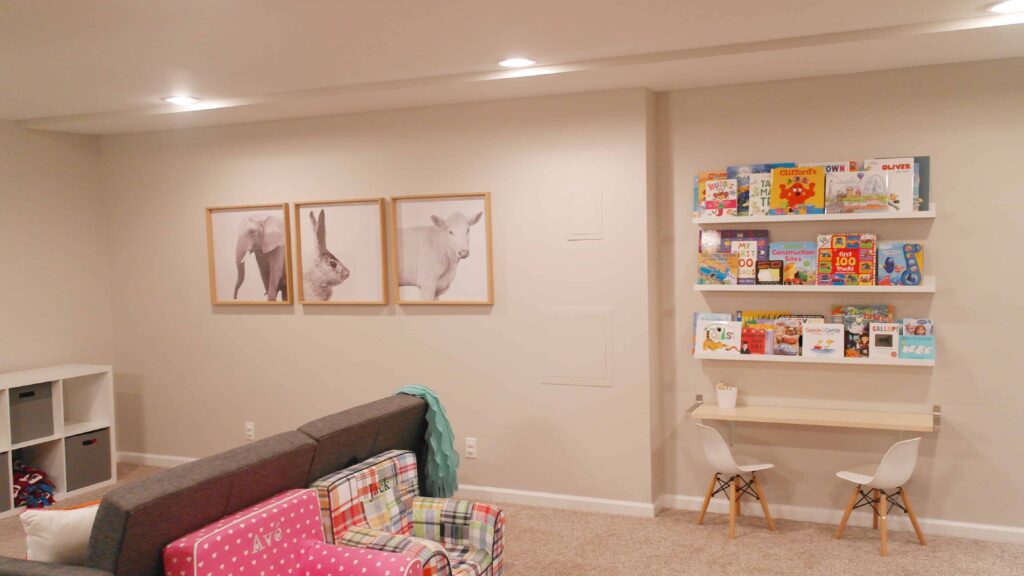
Creating a safe and comfortable playroom in your basement requires thoughtful planning, especially because basements are often prone to moisture, limited natural light, and potential hazards. By focusing on durability, childproofing, and lighting, you can ensure that your children’s playroom is not only fun but also a secure environment where they can explore and play safely.
Choosing Durable and Washable Materials
When designing a basement playroom, selecting durable and washable materials is crucial. Kids can be messy, and basements are more prone to moisture, which can cause wear and tear on materials. Additionally, choosing the right materials can help you get rid of musty smells in your basement, ensuring the space remains fresh and inviting. Opt for materials that can stand up to heavy use and frequent cleaning.
- Flooring: Choose water-resistant flooring options like vinyl, rubber, or cork. These materials are easy to clean, durable, and comfortable for little feet. Rubber flooring, in particular, is shock absorbent, which can reduce injury from falls.
- Furniture: Invest in furniture made from sturdy materials like solid wood or metal. Avoid delicate or easily scratched surfaces. Opt for washable slipcovers for couches and chairs.
- Wall and Upholstery Fabrics: Select fabrics that are durable, stain-resistant, and machine washable. Polyester blends, for example, are strong, easy to maintain, and come in a variety of colors and patterns.
- Play Mats and Rugs: Soft foam play mats or area rugs with washable covers are ideal for creating a comfortable and safe environment. They also provide a cushioned surface to protect against falls.
By choosing materials that are both durable and easy to clean, you can maintain a stylish yet practical playroom that will last as your children grow.
Childproofing Tips for a Basement Playroom
Basements often contain unique hazards, so proper childproofing is essential. Here are some key childproofing tips to ensure your basement playroom is as safe as possible:
- Secure Heavy Furniture: Large furniture like bookshelves or cabinets should be secured to the walls using safety straps to prevent tipping. Children tend to climb, and unsecured furniture can easily topple over.
- Electrical Outlets: Use outlet covers or safety plugs to prevent curious children from sticking objects into outlets. Consider installing tamper-resistant outlets, especially if your basement is still under construction.
- Avoid Sharp Corners: Furniture with sharp corners or edges can be dangerous. Use corner protectors or soft foam padding to reduce the risk of injury from falls or bumps.
- Use Non-Toxic Paints and Finishes: Ensure that any paint, varnish, or finishes used in the playroom are non-toxic and child-safe. Low-VOC (volatile organic compound) paints are an ideal choice, as they are less likely to emit harmful fumes.
- Secure Windows and Doors: Check that windows and doors can be locked securely to prevent children from accidentally opening them. Window guards or safety locks on windows will help keep your children safe.
- Clutter-Free Environment: Keep the space tidy by organizing toys, games, and equipment in bins or storage units. A clutter-free playroom reduces the risk of tripping and falling over scattered objects.
By focusing on safety features such as securing furniture, covering outlets, and using child-safe materials, you can create a playroom where children can play freely without unnecessary risks.
Lighting Ideas to Brighten the Space
Lighting is a critical element in any basement playroom. Basements typically have limited natural light, so you will need to make the most of artificial lighting to create a bright, welcoming environment. Here are some lighting ideas to brighten the space:
- Layered Lighting: Use a combination of ambient, task, and accent lighting to create a well-lit and functional playroom. Overhead lights should provide even illumination, while task lighting like desk lamps or reading lights will help with specific activities. Accent lighting can be used to highlight play areas or create a cozy atmosphere.
- Recessed Lighting: Recessed lights are a great option for basement playrooms as they provide even lighting without taking up space. Install them along the perimeter of the room or above the play area to reduce shadows.
- Bright LED Lights: LED lights are energy-efficient and produce a bright, clear light that mimics natural daylight. Use them in overhead fixtures or in wall-mounted sconces for consistent illumination.
- Colorful Light Fixtures: Bright, colorful light fixtures can add personality and fun to the space. Consider using fun lamps or pendant lights that complement the room’s theme or colors.
- Floor Lamps and String Lights: For a cozy touch, add floor lamps with dimmers or string lights around the room. String lights can also be hung around play areas or along the ceiling to add a playful, whimsical vibe.
- Natural Light Enhancement: If possible, maximize any natural light by using light, reflective window treatments like sheer curtains. If privacy is a concern, opt for shades that allow light to filter through while still providing coverage.
With the right lighting, you can transform your basement playroom into a bright and inviting space that fosters both safety and creativity.
How to Organize Toys and Keep Things Tidy
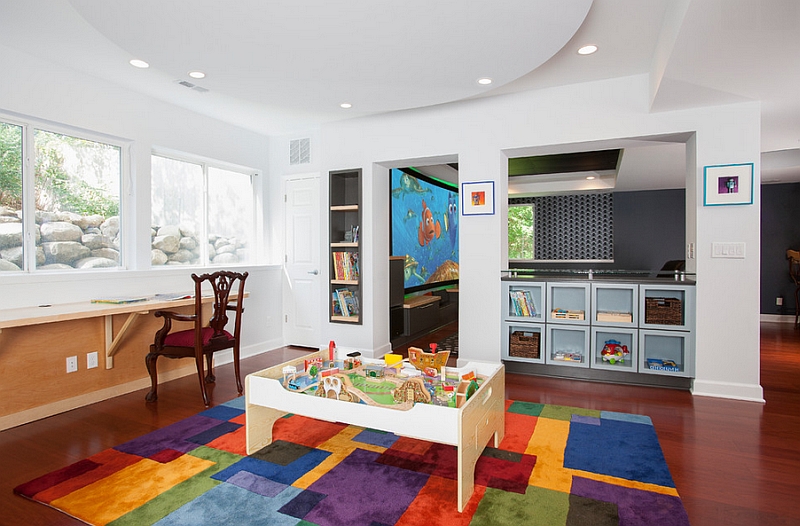
A well-organized playroom is not only visually appealing but also helps foster a sense of responsibility and order in children. Proper organization ensures that toys are easy to find, the space remains functional, and cleaning up becomes a part of playtime. Here are two key strategies for keeping a basement playroom neat and tidy.
Use Baskets, Bins, and Shelves
One of the most effective ways to organize toys in a basement playroom is by using a variety of storage solutions such as baskets, bins, and shelves. These items are not only practical but can also add style and personality to the room.
- Baskets and Bins: These are perfect for storing smaller toys, blocks, or stuffed animals. Labeling baskets and bins with images or words can help children identify where each toy belongs, making cleanup easier. Opt for clear bins so kids can see the contents, or choose brightly colored ones to add a fun touch to the decor.
- Shelves: Wall-mounted shelves are excellent for storing books, art supplies, and decorative items. Low shelves allow children to reach their toys independently, encouraging self-sufficiency. Open shelves keep toys visible, making it easier for kids to find exactly what they want without causing a mess.
- Storage Cubes and Cubbies: Modular storage units, like cubbies or cube organizers, provide customizable storage for toys of various sizes. These are particularly useful for older kids who may have larger toys or collections that require more space. You can even add fabric bins to these cubbies for additional storage flexibility.
- Stackable Storage: Stackable storage bins help you maximize vertical space, which is crucial in a basement playroom where space might be limited. Stackable units are easy to move around, and they allow you to create designated storage areas for different categories of toys.
By using baskets, bins, and shelves, you not only keep the playroom organized but also create an efficient and aesthetically pleasing space that encourages tidiness.
Create Zones for Different Activities
Creating designated zones within the playroom for different activities can help organize the space while also encouraging kids to keep things in their proper places. This strategy is especially useful in larger basement playrooms where multiple play activities are taking place at once.
- Reading or Quiet Zone: Set up a cozy reading nook with soft seating, bookshelves, and a rug. This area can include a few bins for books, and if possible, it should be separate from the more active play areas to reduce distractions during quiet activities.
- Art and Craft Zone: Dedicate a space for arts and crafts, with a sturdy table, chairs, and storage for supplies like crayons, markers, paper, and glue. Use clear bins or labeled containers to store art materials, keeping everything neat and accessible.
- Building Zone: A section of the playroom can be reserved for building toys like blocks, Legos, or train sets. Set up a large table or soft play mats for easy cleanup. Organize building blocks into labeled bins so kids can easily sort pieces by type or size.
- Active Play Zone: If your basement playroom has space, create an active play area for climbing, jumping, or other physical activities. Use soft flooring, like foam mats or carpets, and store the play equipment in baskets for cubbies.
- Toy-Specific Zones: Group similar toys together in specific zones. For example, one area could be for dolls and stuffed animals, while another is for action figures or cars. Having a specific area for each toy category makes it easier for kids to return items to their rightful place.
Creating activity zones helps children know where to find things and where to return them, making tidying up part of the fun. This system also reduces clutter by ensuring that each type of toy has a designated space, minimizing the chance of toys being scattered all over the room.
Budget-Friendly Playroom Ideas
Designing a basement playroom doesn’t have to break the bank. There are plenty of creative ways to make the space both fun and functional while staying within a budget. By focusing on DIY projects and repurposing old items, you can create a vibrant playroom that your kids will love, without overspending. Here are two excellent budget-friendly ideas for your basement playroom:
DIY Decorations and Furniture
DIY projects are an excellent way to customize your playroom and save money. Creating your own decorations and furniture allows you to personalize the space to fit your style, while also making use of affordable materials. Here are a few ideas to consider:
- Wall Art: Instead of buying expensive artwork, consider making your own. You can create colorful canvases with kids’ handprints, abstract designs, or even nature-inspired art using inexpensive materials. You could also frame posters, old magazines, or even children’s artwork to give the room a personal touch.
- Wall Murals or Decals: A painted mural can bring any playroom to life. Whether it’s a nature scene, a jungle, or a space theme, you can use paint or peel-and-stick decals to add visual interest. For an even more budget-friendly option, you can create geometric shapes, stripes, or other simple designs with painter’s tape and wall paint.
- Upcycled Furniture: Instead of buying new furniture, try upcycling old pieces. Sand and repaint an old table or chairs to make them look fresh and new. A coat of bright paint or fun patterns can transform a piece that might otherwise go unnoticed into a fun, functional part of the room.
- DIY Playhouse or Tent: Kids love hideaways, and a homemade playhouse or tent can be a fun and inexpensive addition. Use inexpensive materials like old bed sheets or canvas, PVC pipes, and some basic sewing skills to make a cozy space for reading or pretend play.
- Customizable Storage: Create your own storage solutions with budget materials. Wooden crates, old boxes, or even milk cartons can be transformed into stylish bins or shelves. Painting them in coordinating colors can help unify the room’s aesthetic.
By using DIY decorations and furniture, you can give your basement playroom a unique and personalized touch while saving money on expensive ready-made items.
Repurpose Old Items for Playroom Use
Repurposing old items is another fantastic way to create a budget-friendly playroom. You likely have furniture or materials around your home that can be given a second life in the playroom. Here are some ideas for turning unwanted items into functional playroom essentials:
- Old Furniture: An old coffee table or side table can be repurposed into a toy chest, play table, or even a small craft station. Simply remove or modify drawers, add new handles, or give it a fresh coat of paint. An old dresser can also become a storage unit for toys or books.
- Ladder Shelf: An old wooden ladder can be transformed into a decorative and functional shelf for storing toys, books, or supplies. Just add a coat of paint to match your playroom decor, and you’ll have a charming piece of furniture for minimal cost.
- Repurpose Fabric: Take old bed linens, curtains, or clothes and transform them into new, fun items for the playroom. Use fabric to make throw pillows, wall hangings, or even a fabric play mat. You can also sew a simple curtain or divider to create separate play zones in a larger space.
- Old Suitcases or Baskets: Vintage suitcases, baskets, or crates can be repurposed as toy storage, seating, or decorative accents. Stack a few old suitcases together to create a unique storage unit or use baskets as mobile toy holders that can easily be moved around.
- Repurposed Cardboard Boxes: Cardboard boxes can be painted and decorated to create storage solutions or even DIY playhouses. Children can turn a simple box into a puppet theater, a kitchen, or a race car. They offer endless possibilities for imaginative play and storage without costing a penny.
- Wine Crates or Pallets: Wine crates and wooden pallets are great for repurposing into shelves, storage units, or even seating. A few crates stacked together can provide storage for books, toys, or games, while pallets can be turned into a fun, rustic-style seating area with cushions.
By creatively repurposing old items, you can reduce waste and create a functional, budget-friendly playroom that is both practical and full of character.
How to Make the Playroom Grow with Your Kids
As your children grow, their needs and interests will evolve, and so should their playroom. Instead of designing a space that is only suitable for toddlers or young children, it’s essential to consider how the playroom can be updated and adapted over time to accommodate older kids. With a few smart choices, you can create a playroom that remains fun, functional, and relevant to your children’s changing needs.
Ideas for Tweens and Teens
As kids enter the tween and teen years, their interests and activities shift. The playroom can be transformed from a space full of toys and games to a multi-functional hangout spot that caters to older kids. Here are a few ideas to make the space appealing for tweens and teens:
- Study Area: As children get older, they may need a quiet space to study or do homework. Create a designated area with a sturdy desk, comfortable chair, and proper lighting. You can also add shelving for books and school supplies. Opt for modern and sleek designs to make the study space feel more grown-up.
- Gaming Zone: For tweens and teens, a gaming area can be a great addition. Set up a TV or gaming console with comfortable seating like bean bags, lounge chairs, or even a small sofa. Keep cables organized with cord management solutions and add some fun, customizable decor, such as posters of their favorite games or characters.
- Teen-Style Decor: As children grow, their preferences change. Replace the brightly colored walls and characters with more mature, neutral tones or themes. Add modern, minimalistic furniture and decor like wall art, geometric rugs, or industrial-style lighting to give the room a more sophisticated vibe.
- Hobby Space: Create a section dedicated to your child’s hobbies, whether it’s crafting, painting, building model kits, or playing a musical instrument. Provide storage for supplies, instruments, or other hobby-related items, and ensure the space is adaptable to new interests as they grow.
- Lounge Area: As children become teens, they may appreciate having a chill space to hang out with friends. Create a cozy lounge area with comfortable seating like floor cushions, a sectional, or even a bean bag corner. Add some personal touches with throw pillows, blankets, and maybe a small coffee table for snacks and drinks.
- Flexible Storage: Teens accumulate a variety of items such as books, clothes, gadgets, and keepsakes. Consider multi-purpose storage solutions like lockers, bins with lids, or even under-bed storage. These options help keep clutter at bay while providing space for growing collections.
How to Update the Room Over Time
A playroom that’s designed for young kids may need regular updates as your children grow older. Here are a few tips on how to keep the room fresh, functional, and in line with your child’s evolving needs:
- Rearrange the Layout: As kids get older, their interests and the way they use the space change. Try rearranging the furniture or play areas to better fit their current needs. For example, move the play kitchen out to make room for a reading nook or a larger workspace. Changing the layout periodically can refresh the space and keep it interesting.
- Update Decor with Minimal Investment: A quick and budget-friendly way to update the playroom is by changing out the decor. Swap out colorful curtains, throw pillows, or rugs for more sophisticated patterns and colors that reflect your child’s current taste. Adding some new wall art or changing the bedding can give the space a quick refresh.
- Upgrade Furniture: As your children get older, they may need furniture that suits their size and activities. Upgrade from toddler-size chairs and tables to larger, more comfortable seating and desk space. Opt for furniture that grows with them, like adjustable desks or modular furniture pieces that can be rearranged as needed.
- Add New Activity Zones: Keep the room adaptable by adding activity zones that evolve with your child. For instance, a play kitchen can be replaced with a craft station, or a dress-up corner can turn into a reading nook. As your child’s interests change, switch out old play zones for new ones that better fit their hobbies.
- Incorporate Technology: As kids get older, their technology needs may change. Consider adding a space for devices like tablets, laptops, or a desktop computer. Set up a media station with a TV, gaming console, or music system if your kids are into entertainment and gaming.
- Personalize with Custom Features: Add custom features that reflect your child’s personality. For example, a bulletin board or a corkboard wall can serve as a place to pin up achievements, artwork, or photos. Consider adding a chalkboard or whiteboard for your teen to jot down reminders, goals, or inspirational quotes.
By making small adjustments over time, you can keep the basement playroom fresh and enjoyable for your kids as they grow into their teenage years. A flexible, evolving space allows you to create an area where your children can continue to engage in their favorite activities, while also accommodating their changing interests.
Final Thoughts on Creating the Perfect Playroom
Designing the perfect playroom is about more than just aesthetics; it’s about creating a space where your children can explore, learn, and grow while having fun. Whether you’re transforming your basement into a vibrant play area for toddlers or adapting it for older kids, the key is to make the room functional, safe, and adaptable to your child’s evolving needs.
Here are a few final considerations to help you craft the perfect playroom:
Prioritize Safety and Comfort
A playroom should always be a safe environment for children to express themselves. Ensure the space is childproofed by using non-toxic materials, securing heavy furniture to the walls, and covering electrical outlets. Soft flooring, such as foam mats or area rugs, will cushion falls and add comfort for your kids as they play. Keep safety at the forefront, and you’ll create a space where both you and your children can relax knowing they’re safe.
Foster Creativity and Imagination
A playroom is an opportunity to ignite your child’s imagination. Whether you choose a fun, themed design or a more neutral, flexible space, aim to provide plenty of opportunities for creative play. Incorporate areas for art, building, reading, or imaginative play to encourage your child’s creativity. Add open-ended toys, books, and materials that inspire endless exploration.
Make It Adaptable
As children grow, their needs and interests will change. Designing a playroom that can easily adapt over time will ensure that the space remains enjoyable and useful. Use flexible furniture and storage solutions that can evolve with your child’s age and activities. Create activity zones that can be updated as their preferences shift, and be open to rearranging the layout when necessary.
Keep It Organized
A well-organized playroom will not only look more inviting but will also make it easier for your child to find what they need and clean up afterward. Use baskets, bins, and shelves to keep toys and supplies tidy and accessible. By creating zones for different types of play, you’ll encourage organization while making it easier to maintain the space.
Personalize the Space
Make the playroom a true reflection of your child’s personality by incorporating their favorite colors, themes, and interests. Whether it’s through DIY projects, fun wall art, or personalized storage, adding unique touches will make the space feel like their own. Allow them to have a say in the design, so they can feel connected to the room.
Don’t Forget the Budget
Before transforming your basement into a functional playroom, it’s important to consider the cost to finish a basement. Creating the perfect playroom doesn’t have to come with a hefty price tag. By using budget-friendly options like DIY decorations, upcycled furniture, and repurposed materials, you can create a functional and fun space without overspending. Being creative with what you already have will help you design a playroom that’s both affordable and stylish.
In conclusion, the perfect playroom is one that blends safety, creativity, and functionality while adapting to your child’s changing needs. By designing with flexibility in mind, staying organized, and making the space fun and personal, you’ll create an environment where your child can play, learn, and grow for years to come. With a little creativity and thoughtful planning, the basement playroom can become a cherished space that fosters memories, creativity, and learning.

